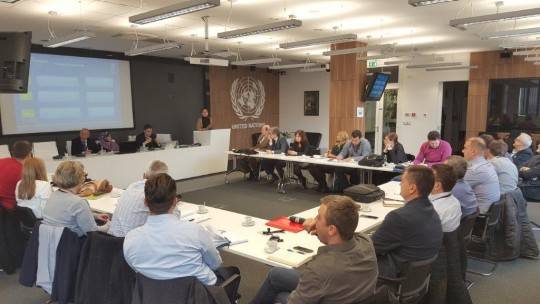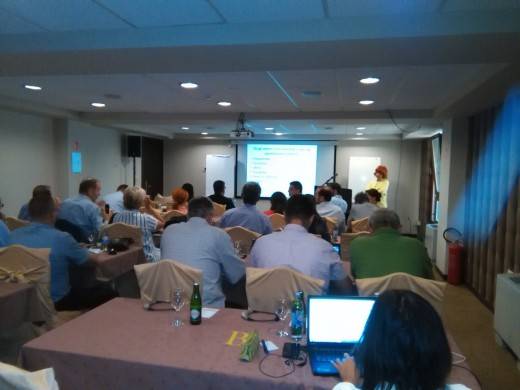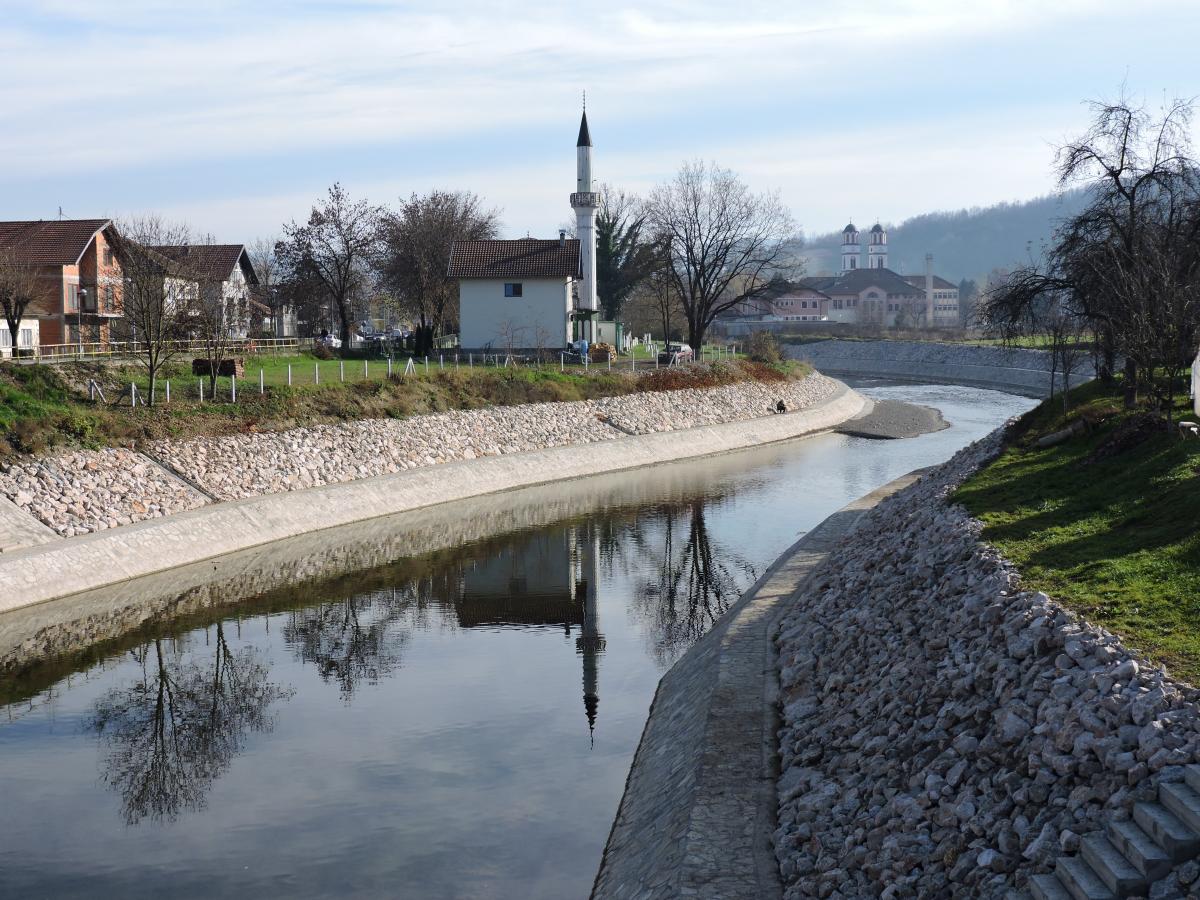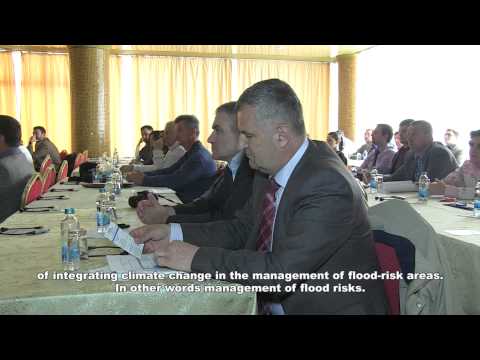Technology Transfer for Climate Resilient Flood Management in Bosnia and Herzegovina's Vrbas River Basin
BiH is significantly exposed to the threats of climate change, but has very limited capacity to address and adapt to its negative impacts, in particular the frequency and magnitude of floods from its major rivers which have tripled in frequency in the last decade. The negative impacts of climate change particularly affect the vulnerable groups within the basin and key sectors such as agriculture and energy (hydropower). Vrbas River basin is characterized by a large rural population comprised of the poorest and most vulnerable communities in BiH, including war returnees and displaced people, with high exposure to flooding and its devastating impacts. In May 2014, Bosnia and Herzegovina experienced its worst flooding in 150 years which resulted in 23 deaths and 2.7 Billion USD worth of damages which is 15% of GDP, and is expected to result in a 1.1% contraction in the economy this year, compared to the growth of 2.2% that had been predicted before the flood.
The project, “Technology transfer for climate resilient flood management in Vrbas River Basin”, will enable the government of BiH and communities of the Vrbas basin to adapt to flood risk through the transfer of adaptation technologies for climate resilient flood management and embark on climate resilient economic activities.
Working closely with state, entity and local governments and institutions the project will enable strategic management of flood risk through the legislative and policy framework and appropriate sectoral policies and plans that incorporate climate change considerations. In order to develop institutional and local capacities in Flood Risk Management (FRM) the project aims to:
- Upgrade and rehabilitate of the hydrometric monitoring network,
- Develop Flood Risk Management plan (FRM) for Vrbas river basin (VRB),
- Develop flood risks and flood hazard maps for the VRB,
- Develop a flood forecasting system and early warning system,
- Develop emergency response plans, and provide trainings in flood-specific civil protection,
- Provide targeted training on climate-induced FRM to over 100 practitioners and decisions makers,
- Prepare institutional capacity development plan for the long-term development of capability and capacity in Flood Risk Management (FRM),
- Implement non-structural interventions in municipalities of the VRB,
- Provide training to local communities in climate resilient FRM, and introduce community-based early warning systems,
- Prepare and implement municipal-level flood response and preparedness plans,
- Implement agro-forestation scheme,
- Introduce financial instruments such as index-based flood insurance and credit deference schemes as a means of compensating for flood damages for agriculture.
Source: Bosnia and Herzegovina's UNDP Project Document (November 26, 2014) and Establishment of hydro-meteorological network in Vrbas River Basin (November 2015)./a>
Project details
Levels of intervention
- Municipality
Source of funds
- Global Environment Facility - Special Climate Change Fund
Key implementers
- Local Governments
- National Governments
Funding amounts
77,260,000 (As detailed in the CEO Endorsement, 21 January 2015.)
Project partners
- Bosnia and Herzegovina Ministry of Foreign Trade and Economic Relations
- Ministry of Spatial Planning, Construction, and Ecology of Republika Srpska
- United Nations Development Programme (UNDP)
- Global Environment Facility (GEF)
Introduction
BiH is significantly exposed to the threats of climate change, but has very limited capacity to address and adapt to its negative impacts, in particular the frequency and magnitude of floods from its major rivers which have tripled in frequency in the last decade. The negative impacts of climate change particularly affect the vulnerable groups within the basin and key sectors such as agriculture and energy (hydropower). Vrbas River basin is characterized by a large rural population comprised of the poorest and most vulnerable communities in BiH, including war returnees and displaced people, with high exposure to flooding and its devastating impacts. In May 2014, Bosnia and Herzegovina experienced its worst flooding in 150 years which resulted in 23 deaths and 2.7 Billion USD worth of damages which is 15% of GDP, and is expected to result in a 1.1% contraction in the economy this year, compared to the growth of 2.2% that had been predicted before the flood.
The project, “Technology transfer for climate resilient flood management in Vrbas River Basin”, will enable the government of BiH and communities of the Vrbas basin to adapt to flood risk through the transfer of adaptation technologies for climate resilient flood management and embark on climate resilient economic activities.
Working closely with state, entity and local governments and institutions the project will enable strategic management of flood risk through the legislative and policy framework and appropriate sectoral policies and plans that incorporate climate change considerations. In order to develop institutional and local capacities in Flood Risk Management (FRM) the project aims to:
- Upgrade and rehabilitate of the hydrometric monitoring network,
- Develop Flood Risk Management plan (FRM) for Vrbas river basin (VRB),
- Develop flood risks and flood hazard maps for the VRB,
- Develop a flood forecasting system and early warning system,
- Develop emergency response plans, and provide trainings in flood-specific civil protection,
- Provide targeted training on climate-induced FRM to over 100 practitioners and decisions makers,
- Prepare institutional capacity development plan for the long-term development of capability and capacity in Flood Risk Management (FRM),
- Implement non-structural interventions in municipalities of the VRB,
- Provide training to local communities in climate resilient FRM, and introduce community-based early warning systems,
- Prepare and implement municipal-level flood response and preparedness plans,
- Implement agro-forestation scheme,
- Introduce financial instruments such as index-based flood insurance and credit deference schemes as a means of compensating for flood damages for agriculture.
Source: Bosnia and Herzegovina's UNDP Project Document (November 26, 2014) and Establishment of hydro-meteorological network in Vrbas River Basin (November 2015)./a>




Project details
Bosnia and Herzegovina (BiH) is a middle income country with an estimated 3.8 million inhabitants, which is still recovering from the 1992-1995 war which had a devastating impact on its human, social and economic resources, leading to enormous challenges of the post-war reconstruction and economic and social recovery. This challenge has been further compounded by the transition towards market economy requiring structural reforms and improved governance. The slow rate of the post-war economic recovery of Bosnia and Herzegovina has been compounded by the negative impacts of climate change on key sectors such as agriculture, energy (hydropower), the environment and, in particular, the frequency and magnitude of flood disasters, which have tripled in frequency in the last decade. In May 2014, Bosnia and Herzegovina experienced its worst flooding in 150 years which resulted in 23 deaths and $2.7 Billion USD worth of damages which is 15% of GDP, and is expected to result in a 1.1 percent contraction in the economy this year, compared to the growth of 2.2 percent that had been predicted before the flood.
BiH is significantly exposed to the threats of climate change, but has very limited capacity to address and adapt to its negative impacts, in particular the frequency and magnitude of floods from its major rivers. The Vrbas River basin is characterized by a large rural population comprised of the poorest and most vulnerable communities in BiH, including war returnees and displaced people, with high exposure to flooding and its devastating impacts. Of the 28 munipalities that make up the Vrbas basin, 13 have experienced flooding in the past decade. Around a third of the rural population of Vrbas Basin (approximately 100,300 people) manage "smallholdings" where they produce fruit, vegetables and livestock products mainly for their own consumption, and about 16% may be classified as "farmers", in that they manage at least 3 ha and/or 3 livestock units. Agriculture is therefore important to the Vrbas River Basin, and the direct impacts of climate change on agriculture such as floods and droughts will inevitably impact the rural communities without any adaptation. Under climate change there is a real risk of reduced crop yields leading to increased food prices, which would in turn have negative implications for food security.
The SCCF funds will be used to enable the communities of the Vrbas basin to adapt to flood risk through the transfer of adaptation technologies for climate resilient flood management, upgrade and rehabilitation of the hydrometric monitoring network, development of a flood forecasting system and early warning system, development of emergency response plans, and provision of training in flood-specific civil protection. Importantly, the project will provide targeted training on climate-induced FRM to over 100 practitioners and decisions makers, and will develop an institutional capacity development plan for the long-term development of capability and capacity in Flood Risk Management (FRM). The project will work closely with affected communities to introduce climate resilient community-based non-structural measures and provide training to local communities in climate resilient FRM. This will include the introduction of agro-forestry, community-based early warning systems, reforestation and introduction of financial instruments such as index-based flood insurance and credit deference schemes as a means of compensating for flood damages for agriculture.
The enabling environment will be enhanced by embedding climate change into key sector policies, strategies and plans to enable climate resilient flood risk management within sectors that impact flood risk significantly, including land use and spatial planning, forestry, agriculture and energy sectors. Specifically, the project will introduce floodplain management regulations that will enhance zoning of development and activities away from high risk areas.
Source: Bosnia and Herzegovina's UNDP Project Document (November 26, 2014).
- Municipality
- Local Governments
- National Governments
- Bosnia and Herzegovina Ministry of Foreign Trade and Economic Relations
- Ministry of Spatial Planning, Construction, and Ecology of Republika Srpska
- United Nations Development Programme (UNDP)
- Global Environment Facility (GEF)
77,260,000 (As detailed in the CEO Endorsement, 21 January 2015.)
News
News: Establishment of hydro-meteorological network in Vrbas River Basin, November 26, 2015
 News: Exchange of experiences for better flood forecasting, February 10, 2016
News: Exchange of experiences for better flood forecasting, February 10, 2016
 Event: The first meeting of the Interinstitutional working group within the project, July 16, 2015
Event: The first meeting of the Interinstitutional working group within the project, July 16, 2015
Exposure Stories
Floods & Livelihoods by Climate Adaptation UNDP on Exposure
Key results and output
Outcome 1. Key relevant development strategies/policies/legislation integrate climate change-resilient flood management approaches
Update at least two priority sectoral policies and plans (e.g. agriculture, hydropower, water resources) to include climate change modeling results (Output 1.1); Update floodplain management and spatial planning regulations and policies to include climate change risks (revision of land use regulations, stricter policy on construction permits in the areas prone to flooding, etc) (Output 1.2); also to codify and disseminate appropriate adaptation technology solutions for climate resilient flood management in BiH (Output 1.3).
Outcome 2. Climate resilient flood risk management is enabled by transferring modern technologies and strengthening institutional capacities
Improved hydrological and hydrodynamic model for the VRB incorporating climate change predictions, developed to produce flood hazard inundation maps for spatial planning and emergency response planning, and for the long-term strategic flood risk management of the VRB (Output 2.1); establishe and institutionalize GIS-based vulnerability, loss and damages assessment tool and database to record, analyze, predict and assess hydro-meteorological and other hazard events and associated losses (Output 2.2); upgrade the hydro-meteorological monitoring system in the VRB (increased from 11 to 25 gauging stations) and harmonize into a central hydrometric system (Output 2.3); Develop institutional capacity strengthening plan and provide targeted training on climate-induced flood risk management to at least 100 practitioners and decision-makers (Output 2.4).
Outcome 3. New technologies and approaches for enhanced flood risk management applied to increase resilience of vulnerable communities in VRB.
Developed integrated land use and flood risk management plan for the VRB and implement non-structural measures by local communities (through Output 3.2.), government and/or private sector (Output 3.1); Implement articipatory community-based adaptation strategies, technologies and practices in priority flood risk areas (e.g. community afforestation scheme on the flood plains as well as establish locally controlled and managed flood zones and watershed rehabilitation works, etc. (Output 3.2); Train local communities (particularly women and refugees) to implement and maintain flood resilient non-structural intervention measures, including agricultural practices such as agro-forestry, to improve livelihoods of 13communities in the VRB, and community-based flood early warning systems (Output 3.3); Modify early warning system in VRB to include the new hydrometric monitoring network as part of a fully-integrated flood forecasting system (comprised of centrally-based and community-based early warning systems) while also preparing and implementing municipal-level flood response and preparedness plans (Output 3.4).
Source: Bosnia and Herzegovina's UNDP Project Document (November 26, 2014).
Reports & publications
Videos & multimedia
Monitoring & evaluation
The project will be monitored through the following M& E activities, which include Inception Workshop and Report; Measurement of Means of Verification of project results; Measurement of Means of Verification for Project Progress on output and implementation; ARR/PIR; Periodic status/ progress reports; Mid-term Evaluation; Final Evaluation; Project Terminal Report; Audit; and Visits to field sites.
A Project Inception Workshop will be held within the first 2 months of project start with those with assigned roles in the project organization structure, UNDP country office and where appropriate/feasible regional technical policy and programme advisors as well as other stakeholders. The Inception Workshop is crucial to building ownership for the project results and to plan the first year annual work plan.
The Inception Workshop should address a number of key issues including:
a) Assist all partners to fully understand and take ownership of the project. Detail the roles, support services and complementary responsibilities of UNDP CO and RCU staff vis à vis the project team. Discuss the roles, functions, and responsibilities within the project's decision-making structures, including reporting and communication lines, and conflict resolution mechanisms. The Terms of Reference for project staff will be discussed again as needed.
b) Based on the project results framework and the relevant SOF (e.g. GEF) Tracking Tool if appropriate, finalize the first annual work plan. Review and agree on the indicators, targets and their means of verification, and recheck assumptions and risks.
c) Provide a detailed overview of reporting, monitoring and evaluation (M&E) requirements. The Monitoring and Evaluation work plan and budget should be agreed and scheduled.
d) Discuss financial reporting procedures and obligations, and arrangements for annual audit.
e) Plan and schedule Project Board meetings. Roles and responsibilities of all project organisation structures should be clarified and meetings planned. The first Project Board meeting should be held within the first 12 months following the inception workshop.
Periodic Monitoring through site visits:
UNDP CO and the UNDP RCU will conduct visits to project sites based on the agreed schedule in the project's Inception Report/Annual Work Plan to assess first hand project progress. Other members of the Project Board may also join these visits. A Field Visit Report/BTOR will be prepared by the CO and UNDP RCU and will be circulated no less than one month after the visit to the project team and Project Board members.
Mid-term of project cycle:
The project will undergo an independent Mid-Term Evaluation at the mid-point of project implementation (insert date). The Mid-Term Evaluation will determine progress being made toward the achievement of outcomes and will identify course correction if needed. It will focus on the effectiveness, efficiency and timeliness of project implementation; will highlight issues requiring decisions and actions; and will present initial lessons learned about project design, implementation and management. Findings of this review will be incorporated as recommendations for enhanced implementation during the final half of the project’s term. The organization, terms of reference and timing of the mid-term evaluation will be decided after consultation between the parties to the project document. The Terms of Reference for this Mid-term evaluation will be prepared by the UNDP CO based on guidance from the Regional Coordinating Unit and UNDP-EEG. The management response and the evaluation will be uploaded to UNDP corporate systems, in particular the UNDP Evaluation Office Evaluation Resource Center (ERC).
The relevant SOF (GEF) Focal Area Tracking Tools will also be completed during the mid-term evaluation cycle.
End of Project:
An independent Final Terminal Evaluation will take place three months prior to the final Project Board meeting and will be undertaken in accordance with UNDP and SOF (e.g. GEF) guidance. The final evaluation will focus on the delivery of the project’s results as initially planned (and as corrected after the mid-term evaluation, if any such correction took place). The final evaluation will look at impact and sustainability of results, including the contribution to capacity development and the achievement of global environmental benefits/goals. The Terms of Reference for this evaluation will be prepared by the UNDP CO based on guidance from the Regional Coordinating Unit and UNDP-EEG.
The Final Terminal Evaluation should also provide recommendations for follow-up activities and requires a management response which should be uploaded to PIMS and to the UNDP Evaluation Office Evaluation Resource Center (ERC).
The relevant SOF (e.g GEF) Focal Area Tracking Tools will also be completed during the final evaluation.
During the last three months, the project team will prepare the Project Terminal Report. This comprehensive report will summarize the results achieved (objectives, outcomes, outputs), lessons learned, problems met and areas where results may not have been achieved. It will also lay out recommendations for any further steps that may need to be taken to ensure sustainability and replicability of the project’s results.
Source: Bosnia and Herzegovina's UNDP Project Document (November 26, 2014).
Newsfeed
Contacts
- Raduska CupacUNDP Project Manager




